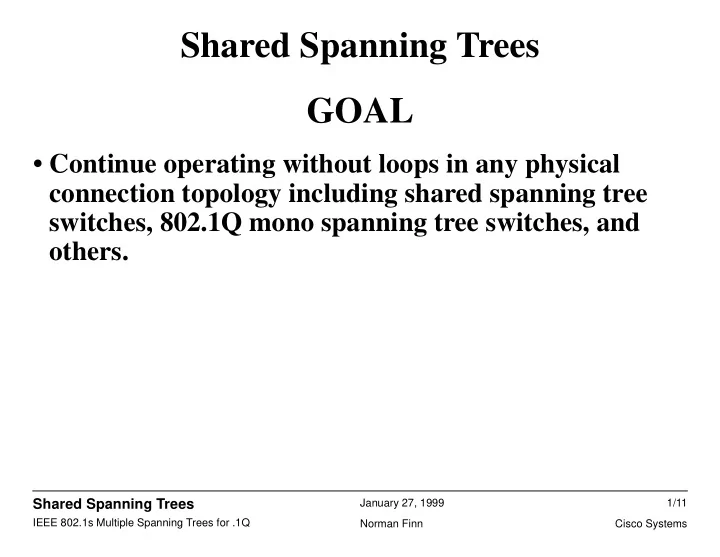

Shared Spanning Trees GOAL • Continue operating without loops in any physical connection topology including shared spanning tree switches, 802.1Q mono spanning tree switches, and others. Shared Spanning Trees January 27, 1999 1/11 IEEE 802.1s Multiple Spanning Trees for .1Q Norman Finn Cisco Systems
Shared Spanning Trees (Definitions) • MST: Mono Spanning Tree (current 802.1Q) • SST: Shared Spanning Tree (proposed 802.1Q) • PVST: Per-VLAN Spanning Tree (in common use) • CST: Common Spanning Tree. The spanning tree for VLAN 1, the only current 802.1Q spanning tree. • Access Port: Only one VLAN, not tagged. • Trunk Port: Perhaps multiple VLANs, perhaps tagged. Shared Spanning Trees January 27, 1999 2/11 IEEE 802.1s Multiple Spanning Trees for .1Q Norman Finn Cisco Systems
PVST Region SST SST Region Region PVST Region MST Region MST Region Figure 1. Interconnected Regions Shared Spanning Trees January 27, 1999 3/11 IEEE 802.1s Multiple Spanning Trees for .1Q Norman Finn Cisco Systems
SST backbone PVST PVST Region Region MST MST Region Region Figure 2. Most Common Situation Shared Spanning Trees January 27, 1999 4/11 IEEE 802.1s Multiple Spanning Trees for .1Q Norman Finn Cisco Systems
Basic Plan • BPDUs for SST regions are tunnelled through MST regions. We use a new destination MAC address for SST BPDUs. — Because MST region will combine all BPDUs sent to old address into a single spanning tree. • All MST spanning trees are mapped to the CST. • Temporary loops occur in 802.1D when wires come and go. • Interruptions in data transmission caused by 802.1D/Q spanning tree disruptions are equivalent to wire changes for tunnelled BPDUs. Shared Spanning Trees January 27, 1999 5/11 IEEE 802.1s Multiple Spanning Trees for .1Q Norman Finn Cisco Systems
Preventing Temporary Loops • SST switches get “more important” root priority, to keep the spanning tree roots in the backbone. — This forces MST regions with multiple connections to the SST backbone to partition. • SST region meshed so single failures won’t partition it. • CST only has shorter forward delay time. — Provides insurance against root bridge being in an MST cloud. Shared Spanning Trees January 27, 1999 6/11 IEEE 802.1s Multiple Spanning Trees for .1Q Norman Finn Cisco Systems
Nasty Loop SST Red port 6 is designated: Blue(2) Red(1) Red port 8 is designated: port 6 is better than port 8 No red BPDUs received 8 6 PVID = blue PVID = red SST BPDU(red): 1 is root IEEE BPDU(red): 1 is root IEEE BPDU(blue): 1 is root SST BPDU(blue): 2 is root SST BPDU(blue): 2 is root SST BPDU(red): 1 is root PVID = blue PVID = red Port 5 is designated: Port 4 is root port (root = 1) 5 4 No BPDUs received. MST Red VLAN has a loop. Shared Spanning Trees January 27, 1999 7/11 IEEE 802.1s Multiple Spanning Trees for .1Q Norman Finn Cisco Systems
Nasty Loop (continued) • This is why MST spanning trees are assigned to CST. — If all IEEE BPDUs are CST, and not red or blue, loop goes away. • This is why the distinction between access ports and trunk ports. — Trunk ports really need to stay up. — Access ports are a common reality. — Detecting the reception of anomalous BPDUs and blocking the port is acceptable for access ports. Shared Spanning Trees January 27, 1999 8/11 IEEE 802.1s Multiple Spanning Trees for .1Q Norman Finn Cisco Systems
Normal Configuration PVST C PVST Tagged BPDUs sent PVST PVST to the IEEE address, no untagged BPDUs. PVST D SST PVST PVST 1Q 1Q 1Q Tagged BPDUs sent to the new address, untagged to the IEEE one. 1Q MST Shared Spanning Tree (primary VLAN) PVST Spanning Tree (secondary VLAN in SST region) Shared Spanning Trees January 27, 1999 9/11 IEEE 802.1s Multiple Spanning Trees for .1Q Norman Finn Cisco Systems
BPDU Rules for SST bridge (transmit) • When sending BPDU on trunk port: — If CST BPDU, use 802.1D address, untagged. — If non-CST non-PVID BPDU, use new address, tagged. — If non-CST PVID BPDU, use new address, untagged. • When sending BPDU on access port: — If primary VLAN in group, use 802.1D address, untagged. — If secondary VLAN in group, use new address, untagged. Shared Spanning Trees January 27, 1999 10/11 IEEE 802.1s Multiple Spanning Trees for .1Q Norman Finn Cisco Systems
BPDU Rules for SST bridge (receive) • From trunk port: — If untagged IEEE BPDU, assign to CST. — If sent to SST address, process according to which VLAN (spanning tree group) it belongs to. • From access port: — If IEEE BPDU and port PVID is primary VLAN of spanning tree group, assign to that spanning tree. — If sent to SST address, block the port. Shared Spanning Trees January 27, 1999 11/11 IEEE 802.1s Multiple Spanning Trees for .1Q Norman Finn Cisco Systems
Recommend
More recommend